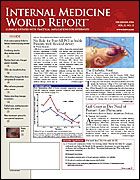Publication
Article
Internal Medicine World Report
HIV Ambulatory Care Programs Show Mixed Results
Author(s):
From the International AIDS Conference
TORONTO—An ongoing study of HIV ambulatory care programs in the United States shows that although most patients are being appropriately managed, improvements in quality of care have plateaued in the last year or so, and few infected persons are being screened for mental illness, dental disease, cervical cancer, or tuberculosis (TB), investigators reported at the XVI International AIDS Conference.
“One of the most important points is that there are improvements overall in HIV care from year to year,” said Bruce D. Agins, MD, MPH, director of the national HIV Quality of Care (HIVQUAL) project and the AIDS Institute, New York State Department of Health. “But there are also some basic public health screening tests that don’t appear to be performed as frequently as one would hope. One example is dental screening, for which internists can refer patients. And mental health screening—which should be done directly by internists—is particularly important, since prevalence [of psychological disorders] is high among people living with HIV.”
In 1997, HIVQUAL began issuing report cards to individual ambulatory care programs and producing composite national scores of 19 parameters, including whether CD4+ cell counts and viral loads are being monitored at least twice yearly, whether patients are being screened for TB annually, and whether overall therapy is being managed appropriately.
The number of sites and patients involved in the project has risen every year, enhancing the validity of the results. From 2004 to 2005, for example, the number of patients jumped from 4729 to 6888, and the number of participating clinics rose from 87 to 94. The 2005 patient sample was comprised of 47% blacks, 30% Hispanics, and 19% whites. A total of 43% were men, 64% were aged 30 to 49, and 56% had been infected through heterosexual sex.
The percentage of patients receiving appropriate antiretroviral therapy in the previous 12 months rose steadily through 2004, when it reached 63.2%. But in 2005, it dropped to 60.9%. In recent years, patients with stable disease were far more likely to receive appropriate care.
In contrast, rates of appropriate management among unstable patients were 72.6% in 2004 and 69.9% in 2005.
But notable gaps in care were also evident. The worst pertained to oral health, with just 37.8% of clinics reporting that they performed annual dental health checkups in 2005.
The rate of annual TB screening was also dismal, at 53.7%. Perhaps most shocking, just 24.1% of clinics reported that in 2005 they performed a thorough annual mental health evaluation, including monitoring of cognition, depression, anxiety, sleep, and appetite and evaluating for the presence of domestic violence or posttraumatic stress disorder.






